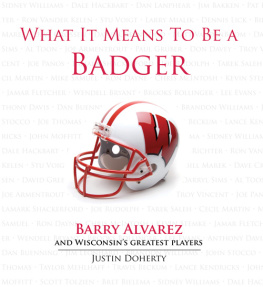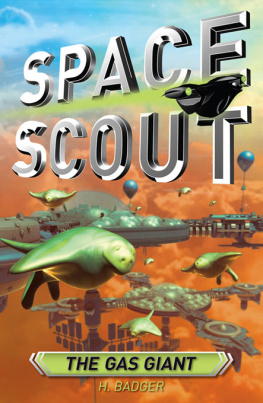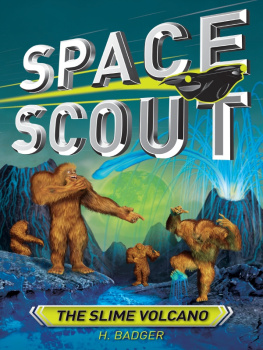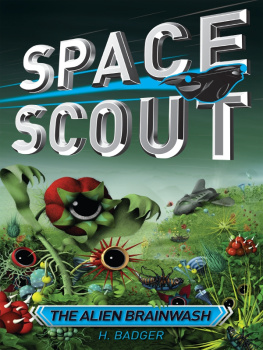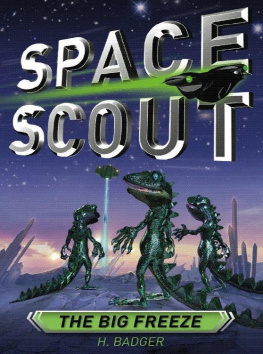Timothy J Roper - Badger
Here you can read online Timothy J Roper - Badger full text of the book (entire story) in english for free. Download pdf and epub, get meaning, cover and reviews about this ebook. City: London, year: 2010, publisher: Collins, genre: Romance novel. Description of the work, (preface) as well as reviews are available. Best literature library LitArk.com created for fans of good reading and offers a wide selection of genres:
Romance novel
Science fiction
Adventure
Detective
Science
History
Home and family
Prose
Art
Politics
Computer
Non-fiction
Religion
Business
Children
Humor
Choose a favorite category and find really read worthwhile books. Enjoy immersion in the world of imagination, feel the emotions of the characters or learn something new for yourself, make an fascinating discovery.
- Book:Badger
- Author:
- Publisher:Collins
- Genre:
- Year:2010
- City:London
- Rating:3 / 5
- Favourites:Add to favourites
- Your mark:
- 60
- 1
- 2
- 3
- 4
- 5
Badger: summary, description and annotation
We offer to read an annotation, description, summary or preface (depends on what the author of the book "Badger" wrote himself). If you haven't found the necessary information about the book — write in the comments, we will try to find it.
Badger — read online for free the complete book (whole text) full work
Below is the text of the book, divided by pages. System saving the place of the last page read, allows you to conveniently read the book "Badger" online for free, without having to search again every time where you left off. Put a bookmark, and you can go to the page where you finished reading at any time.
Font size:
Interval:
Bookmark:
SARAH A. CORBET, SCD
PROF. RICHARD WEST, SCD, F R S , FGS
DAVID STREETER, MBE, FIBIOL
JIM FLEGG, OBE, FIHORT
PROF. JONATHAN SILVERTOWN
The aim of this series is to interest the general reader in the wildlife of Britain by recapturing the enquiring spirit of the old naturalists. The editors believe that the natural pride of the British public in the native flora and fauna, to which must be added concern for their conservation, is best fostered by maintaining a high standard of accuracy combined with clarity of exposition in presenting the results of modern scientific research.
To
Larissa, Vanja, Conrad and Laurence

Eurasian badgers Meles meles. (H. Clark)
B ADGER IS A NEW DEPARTURE for the New Naturalist Library: a volume on a single species in the main series. As Professor Roper also points out, it is the replacement for the very first volume in the original monograph seriesErnest Neals The Badger. We aim to produce further volumes on single species, but only where they are the sole representative of their group in the UK, or where there is a considerable scientific interest and information available for the species.
The badger Meles meles is a perfect example of a species that qualifies on both counts, so is the ideal subject to start with in this new departure for the main series. As the largest naturally occurring carnivore currently found in the UK, it is perhaps surprising that it is not seen more often in the British countryside, but its cryptic lifestyle means that it often goes unnoticed. It is also one of the most social of UK mammals, a lifestyle that makes it attractive to nature lovers. This combination of scarcity and popularity means that members of the speciality Badger Groups are the most likely people to see these fabulous animals and probably accounts for such groups being the most numerous single species groups in the country. As a social animal, the badger has also been intensively researched for many years. Recently, its implication in the transmission of bovine tuberculosis has increased interest in and scientific study on this species and has resulted in the badger becoming the centre of a controversy surrounding the control of the British and Irish populations.
There is thus no better moment than now for an in-depth description of the species lifestyle to be published by the UKs leading badger scientist, someone who has shared the badgers position at the centre of the controversy. As a considered view of the facts behind this fascinating animals life, this book is a timely contribution to the history of its study and a worthy replacement for Ernest Neals original volume in the series.
M OST BADGER LOVERS WOULD agree that the first proper badger book was the New Naturalist Monograph written by Ernest Neal and published by Collins in 1948. It is a privilege to be allowed to follow in Ernests footsteps, for several reasons. First, his was the first single-species volume in the original New Naturalist series, just as this is the first single-species volume in the new series. Second, Ernests knowledge and love of badgers were unrivalled. Third, and by no means least, he was one of the kindest and most modest people one could ever hope to meeta real authority but one who wore his erudition lightly and was always willing to share it. I have thought about him often during the writing of this book.
Ernest wrote three books about badgers, the most recent of which, co-authored with Chris Cheeseman, was published in 1996. Why, then, do we need another? The main reason is that during the last 15 years an enormous amount of new research on badgers has been published that not only adds, quantitatively, to what we know about the species but also materially changes our view of what badgers are like. In some respects, it is almost as though the old badger that we knew and loved has been replaced by a different animal. For example, whereas we had always assumed that badgers live in relatively large social groups, as they do in the UK, we now know that they exist in quite small groups or pairs over much of their geographical range. Similarly, whereas early studies had suggested that badgers were strictly territorial, we now know that movements between social groups are quite common and that, in some populations, territoriality is much less evident. Again, whereas we used to think that badgers fed mainly on earthworms, we now know that their diet is much more catholic and that in some parts of their range they eschew earthworms altogether. And whereas we used to think that breeding outside the social group was rare, we now know that it happens all the time. Even the basic taxonomy of badgers is being questioned.
These latest insights about badgers have come partly from the application of new techniques, particularly in the field of molecular genetics. More importantly, however, they have originated from research conducted in countries other than the UK, which has given us a wider, richer and more representative view of the species. Outstanding studies of badgers in the Doana reserve in southern Spain, in the Serra de Grndola in Portugal, in the Biaowiea Primeval Forest in Poland, and even in the suburbs of Tokyo and Yamaguchi City, Japan, have fundamentally changed our ideas about many aspects of badger behaviour. The picture that emerges is of a remarkably adaptable and resourceful animal that, despite now being one of the worlds best-studied mammals, can still regularly surprise us.
My purpose has been to review, as completely as is feasible in a book of this type, the existing scientific literature on badgers. I have taken this approach rather than a more anecdotal or descriptive one, because, as a scientist, I want to explain why things are the way they are. This means being interested in hypotheses and interpretations as well as in natural history per se. The difficulty, of course, is in conveying the nuts and bolts of hard scientific information and the excitement of ideas in an intelligible manner, without oversimplifying and, even more importantly, without losing the sense of wonder and delight in nature that motivates every enthusiastic naturalist and every professional biologist. This is what I have tried to do.
Many people helped to make the book a reality. David Streeter first suggested that I write a badger book and I could not have done so without the support and facilities of the University of Sussex. Chris Cheeseman and Peter Lps read the entire manuscript, while John Davison, Maren Huck and Noel Smith read parts of it. Their comments were invaluable and resulted in many improvements to the text. The responsibility for any remaining errors or omissions rests, of course, with me.
The Badger Trust kindly put out a call for photographs, and the following people very generously supplied me with images or other illustrative material: Alexei Abramov, Brian Andrews, Marc Baldwin, Keith and Colleen Begg, Karen and Martin Blackman, Nick Brickle, the Centre for Ecology and Hydrology, Hugh Clark, Michael Clark, Elizabeth Close, Dan Collins, Miranda Cowan, Tim Crawshaw, Barry Crowley, Dan Danahar, Aparajita Datta, Dassenwerkgroep Brabant, John Davison, Dez Delahay, Ray Dixon, Emmanuel Do Linh San, Michael Edwards, Carol Evans, the Food and Agriculture Research Agency, Tony Goodchild, Kurt Grossenbacher, Julia Hurst, Valerie Hutchin, Ian Hutchison, Md, Anwaral Islam, Gareth Jones, Yayoi Kaneko, Andrew Kelly, Rafa Kowalczyk, Richard Lawrence, Roland Lowery, David Malins, Simon More, Paul ODonoghue, Sue Old, Mike Rendle, Eloy Revilla, Luis Rosalino, Thomas Scheppers, Lesley and Peter Schofield, Scottish Badgers, Graham Shepherd, Chris Smal, Noel Smith, Lynsey Stuart, Michele Taylor, Willy Thssen, the University of Sussex, Hans Vink, VLA Weybridge, Alastair Ward, Simon and Jane Wild, and Neil Yeo. Michael Clark also generously allowed me to reproduce some of his drawings of badgers and Keith Hunt produced electronic versions of these and other hard-copy illustrations. Oliver Keuling kindly provided data on badger population densities in Germany and elsewhere, and Emmanuel Do Linh San data on hunting bags in Switzerland. The following publishers allowed me to reproduce material without charge (others were less charitable): Elsevier, the Finnish Zoological and Botanical Publishing Board, Koninklijke Brill NV, the Editors of
Font size:
Interval:
Bookmark:
Similar books «Badger»
Look at similar books to Badger. We have selected literature similar in name and meaning in the hope of providing readers with more options to find new, interesting, not yet read works.
Discussion, reviews of the book Badger and just readers' own opinions. Leave your comments, write what you think about the work, its meaning or the main characters. Specify what exactly you liked and what you didn't like, and why you think so.


